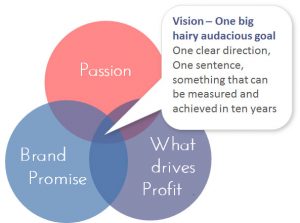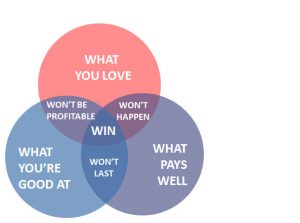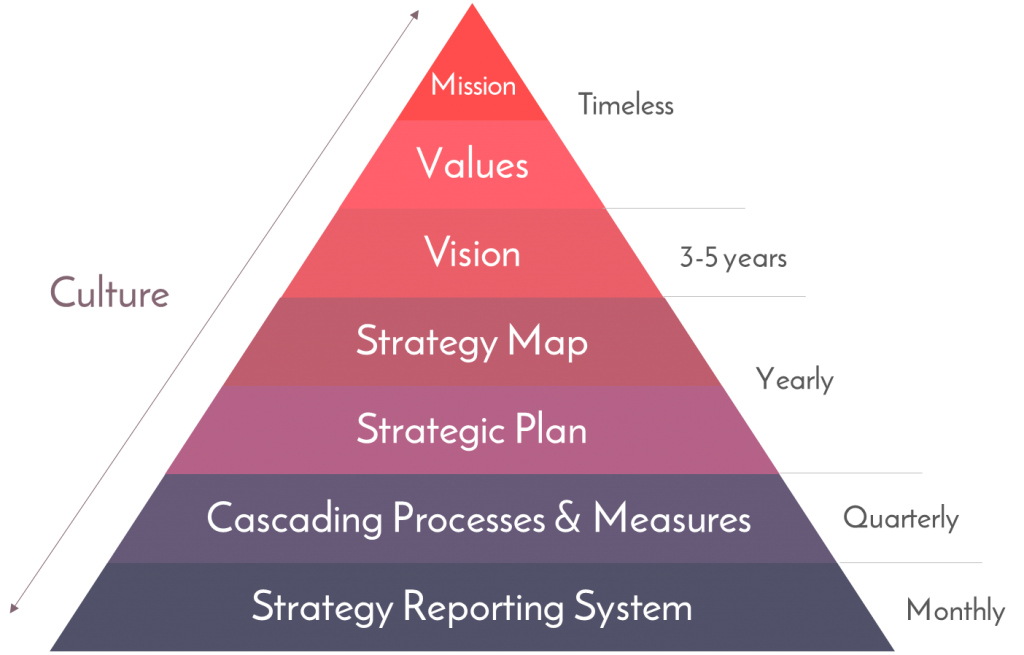This pyramid shows how the components of your strategy build of each other. The times on the right indicate ideally how often these should last.
Do any of these statements characterise your business?
“Business is growing, but I seem to be spending more and more time managing staff and customers.”
“ There is more to do and more tension in the air. We are all working really hard day after day.”
“ I assume we are progressing, but if you asked me how I couldn’t really prove it.”
This is the cry of a business who doesn’t embrace a strategy management system.
The problem: Everyone thinks they are a “Strategy Expert”
I have worked as a business strategy consultant for years. One of the biggest hurdles I have is that everyone thinks they are a ‘strategy expert.’ In most cases they are woefully uninformed. Owning a business doesn’t automatically mean you understand strategy.
This guide explains just how simple it is make strategy work for you.
Mission – core purpose of the organisation
Many companies confuse their mission and vision statements; and nearly all companies haven’t articulated them clearly. Your businesses mission is your reason for being. Walt Disney’s mission isn’t to make movies (that’s a product). It is to “make people happy.” This is a mission that will never change in a hundred years.
Values – timeless guiding principles
I often walk into offices and see value statements written on the wall. Statements designed to motivate staff. Values like: ‘We respect each other’, ‘we deliver results’, and ‘we own our mistakes’. 90% of the time these are not the organisations values.
They could be values, but what the team does in practice is what matters, not what you write on the wall. Values are the guiding principles of your company that apply to every employee regardless of their rank or role. Like the mission statement this is a foundational element of your company and once you get this right it should never change. You hire staff based on their alignment to your values. You test business decisions and culture development against your values. Values should be taken very seriously. Values empower the success of the business. Without them culture doesn’t develop and your business outcomes are rarely met
Vision – a picture of the ideal future in words
Your vision is what your business will look like when you apply your mission. This is the tangible picture of the intangible mission statement. This needs to be very specific and represent the intersection between:
- What you are passionate about
- What your brand promised to be the best at
- What drives profit


Your vision (or biggest company goal) is the intersection between your passion, your brand promise and what drives your profit
To develop a vision statement keep your values and mission in mind and then write what Jim Collins calls a ‘vivid’ description. It is not enough to just write a technical goal. It needs to be a goal that the team aspires and rallies around, something that makes sense to them. Imagine 3-5 years into the future and describe an emotive story of what your world will look like when you have achieved this vision.
Strategic Plan – your competitive “game plan” for success
A strategy is simply a set of objectives. You start by writing the high level objectives that will make your vision a reality. Then you identify how you will achieve the high level objective. You keep on defining more and more detail until you have a business plan. Your aim is to have enough detail so you can answer questions like:
- What resources do we need?
- How will we structure ourselves?
- Where will we operate?
Strategy Map – graphical presentation of key objectives
Every employee needs to see where their role fits into the business strategy. The best way to do this is to represent your business plan in a one page strategy map.
The map is best organised in line with the balanced scorecard perspectives. This includes: financial health, customer health, process health and learning and growth. In other words, management must regularly and scientifically answer the following questions:
- How well are we meeting the wants of the owner?
- How well are we meeting the wants of the customer?
- How well are our business processes working?
- How well are we doing at improving our business systems and developing our staff?
An example of a balanced scorecard strategy map. Linking the four perspectives of your business onto a strategy on a page.
See a video explanation of the Balanced scorecard here.
Cascading Processes & Performance Measures – all departments/individuals that align with overall objectives
A good manager makes each role explicitly clear and holds staff accountable. To achieve this, processes and KPIs are cascaded throughout the organisation. Cascading is the art of aligning all of the individual’s roles up through the organisational hierarchy to achieve the business’s outcomes.
Here is an example of aligning processes up through the department to a high level process on the strategy map:
For each process you have performance measures that will cascade as well. For example:
- The marketing manager needs to increase total revenue by $250k
- Then the sales department has the target of increasing the percentage of repeat sales within the month
- Then the sales rep has the target of reaching ten existing customers on social media a week
“If you don’t measure, it’s like writing your goals down in Sand” – Dr Robert Kaplan
Strategic Reporting System – align the performance measures to the rest of the business
This is where the strategy comes off the page. On a monthly basis (or more often) you enforce all employees to report on their performance targets. Each team member is responsible for their performance targets. When a target isn’t met the person accountable asks why that happened and explore the root cause of the problem. They then identify how to make sure they are on target next month by identifying and planning specific corrective actions.
Now you know the basics of how real strategy works
These 7 components of strategy can sound complicated. But, this is the minimum level of structure a business needs to grow and prosper. If you have specific questions or want to see a practical example, please ask a question below or get in touch.


